|
As with most other forms of aircraft technology the world of gliders
has changed significantly in the last half century. The relatively
high drag fuselages and low aspect ratio wings, and the wood frame
with fabric covering used on most of the sailplanes at the 15th
National Soaring Contest is definitely old school compared to today's
sleek foam, fiberglass, and carbon fiber airframes that have been
computer optimized for drag reduction, speed, and lift generation.
Dr. Paul MacReady and son Paul, Jr. were on the scene way back then,
and then again in the
20th National Soaring Contest in November 1953 Air Trails
and the
21st National Soaring Contest as reported in the December 1954
edition of Air Trails.
15th National Soaring Contest
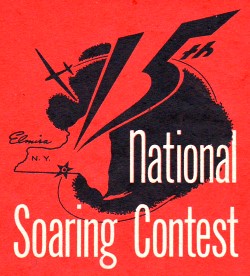
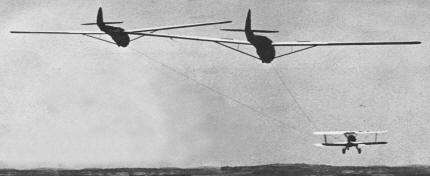
Elmira's Thermals Smile on the Contestants of the 15th National
Meet and Elect a New Champion
Soaring pilots flew a total of 10,320 miles, made 629 take-offs
and enjoyed the hospitality extended to them and their crews by
the citizens of the town during the competition. Although meteorological
conditions were not as good as those encountered last year in Texas,
only two of the twelve days were unsuitable for soaring. Nevertheless,
the meet proved to be highly successful. Much of this was due to
the revised and improved contest rules which eliminated both duration
and altitude from the point award system leaving the contestants
to compete for distance alone. Points were given for flights only
beyond 25 miles and the point award fund, totaling $3,700, was divided
according to the point value of a contestant's five best flights.
In order to qualify, the final score of the pilot could not be less
than 25% of the average of the three highest contestant scores.
Another innovation was the fund of $1,000 set aside by the Elmira
Area Soaring Corporation, sponsors of the meet, as travel pay for
pilots coming from points located beyond a300-mile airline distance
from Elmira.
|
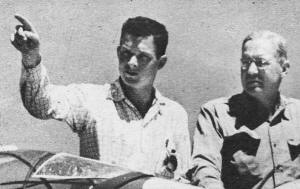
Father and son team, Champion Paul MacCready, Jr., and
Dr. MacCready who was his crew chief.
|
The contest always attracts pilots who enter less for the serious
competition than for the fun of flying and the personal satisfaction
of having participated in the most important soaring event of the
year. Two classifications were established which graded entrants
as "Contestants" or "Participants." While Contestants had more privileges
and were eligible for point award money, Participants were given
prizes for special activities such as altitude, spot landing, duration,
speed dashes and aerobatics. For the most part these events centered
around Harris Hill and afforded the spectators a fine view of sailplanes
in action.
Another event offered for the first time was the Aerobatic Championship
for which $500 in prize money was donated by the local Henry B.
Bentley Post, American Legion. The winner was Kim Scribner, master
pilot for Pan American Airways. He executed rolls and flew inverted
while still in tow and was the only pilot to do the difficult outside
loop after releasing from the tow plane.
Total prize fund in money and merchandise distributed to contestants
and participants was $12,500 - the largest yet - and practically
every pilot took home some sort of reward.
The 70 contesting pilots who brought 50 sailplanes to Harris
Hill were whisked into the air every day as soon as contest meteorologist
Barney Wiggins compiled the daily weather information. His unerring
judgment as to where best thermals were to be found and what direction
to take in order to obtain best performance, was largely responsible
for many of the very good flights made by the contestants.
|
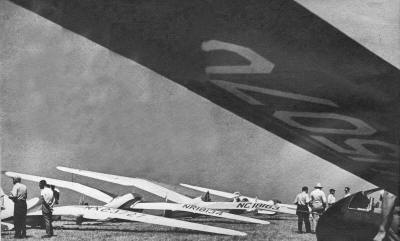
Back to its home town of Elmira, N. Y., came the 15th
National Soaring Contest, having splurged last summer with
Texas thermals at Wichita Falls.
|
Although from standpoint of soaring, the weather was far from
sensational, thermal conditions were sufficiently good to carry
sailplanes with fairly heavy wing loadings to distances of more
than 150 miles. The best flight of the meet was made by Paul MacCready,
Jr., of New Haven, Conn. Piloting his Polish built, red and white
Orlik sailplane, MacCready landed at Middlefield, Ohio - 222 miles
from Harris Hill. This was the first long distance flight into the
West made from Elmira. Earlier, MacCready made a "goal" flight of
167 miles to Trenton, N. J. to win the prize of $250 offered by
Michael Stroukoff, President of Chase Aircraft Corp.
MacCready, through his clever flying, then advanced from second
to first place, which was held in the beginning by the veteran soaring
pilot John Robinson, three times National soaring champion. MacCready
cinched the championship with his flight to Ohio, piling up all
his points on the first five flights, not one of them being under
140 miles. Next best . flight in distance was made by Robinson who
soared 178 miles to New Midway, Md., in the famous Air-100 sailplane
(Feb. 1948, Air Trails) lent to him by the French Embassy. Don Pollard
of Roanoke, Va., reached Altoona, Pa., 142 miles from Elmira, taking
third place on his points. Other notable fights were made by Eastern
Airlines captain Fritz Compton of Miami - 163 miles; Ray Parker
of Twenty Nine Palms, Calif. - 146 miles; Bill Coverdale of Chattanooga,
Tenn. - 143 miles; and Steve Bennis of Sanford, Fla. - 128 miles.
Despite the fact that Harris Hill is a one-way field, with a
runway less than 2,000 feet in length, five tow planes relegated
to the task of launching sailplanes did a fast and efficient job
of towing. On one occasion, 39 gliders were sent on their way in
one hour. The smooth operation drew high praise from the Swiss,
French, British, Hindu and other foreign observers who viewed the
contest.
|
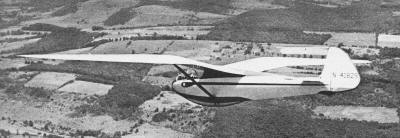
The graceful Kirby Gull flown by Emil Lehecka of New
York starts out on a cross-country flight. This is a fine
example of superior home-built craftsmanship.
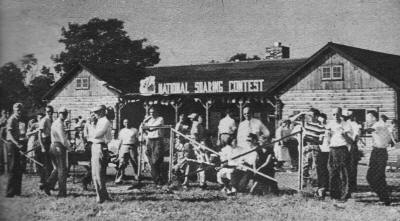
The gang at the 15th National Soaring Contest.
|
Considerable interest was shown by the spectators as well as pilots
in the daily Air Force show during which a CG-15 cargo glider was
snatched from the ground by a C-47 transport. Upon release, the
heavy glider went through a series of aerobatics, which drew gasps
from the crowd and officials, ending with a spot landing back on
Harris Hill. Another daily spectator event which attracted wide
attention was a parachute jump by Dick Ward from a two place Pratt-Read
glider flown by Richard McGrath of Elmira, Air-to-ground radio broadcasts
through loud speaker system, from both Air Force glider and the
Pratt-Read furnished additional interest.
Majority of participating sailplanes were the familiar surplus
machines, so popular since the war: Laister-Kauffmanns, Schweizer
TG-2s and TG-3s, and Pratt-Reads, some of them dolled up for better
performance. The non-military types included two Minimoas, one owned
by William Coverdale and the other by Lyle Maxey and Charles Kohls
of Detroit. Others included John Robinson's Ross-Stephens Zanonia,
MacCready's Orlik, a Kirby Kite flown by Steve Bennis, the Kirby
Gull piloted by Emil Lehecka of New York City, Richard Corney's
Schweizer 1-21, the Screamin' Weiner entered and flown by Wally
Weiberg of Dallas, Texas, Bill Bowmar's Rigid Midget flown by Ray
Parker (in which he won fourth place) and the two newcomers, an
all-metal Schweizer SGS-1-23 owned and flown by William Frutchy
of Elmira, and the Tiny Mite flown by Dick Johnson of California.
The SGS-1-23 at first glance is reminiscent of the 1-21. However,
this newer ship, was designed and built especially to take advantage
of weak thermals. It has a considerably lighter wing loading than
the 1-21 and a stalling speed of only 31 mph, 10 miles below that
of the 1-21. The sailplane is all-metal, even to the control surfaces
and is practically immune to deterioration due to weather. The wing
has a straight planform to about 50% of the span and is tapered
from there to the tips. Schweizer took three weeks to build it and
the organization feels that it can market the sailplane at a reasonable
figure. On the other hand, Tiny Mite, lives up to its moniker. It's
a very small all-wood sailplane Having only 84 sq. ft. wing area.
It was designed for fast cross-country flights under strong thermal
conditions. Inasmuch as the ship weighs fully loaded 630 lbs. and
has a wing loading of 7.4 lbs. sq. ft. (considered very high for
sailplanes), Fowler flaps had to be incorporated in order to enable
the sailplane to make small diameter turns. Unfortunately Elmira
thermals were too weak for the Tiny Mite, and this interesting design
had little chance to show its worth. Another interesting sailplane
was a Laister-Kauffrnann flown by Eugene Miller of Miami, Fla.,
and Kempes Trager of Detroit, Mich. Miller went to the extreme in
streamlining and lightening the ship by cutting off the turtle deck,
sealing the glider entirely against air leaks and equipping the
cockpit with a bubble canopy similar to P-80s. The revamped LK stalled
12 mph below its stock sister and had a considerably better glide
angle and greatly reduced sinking speed.
|
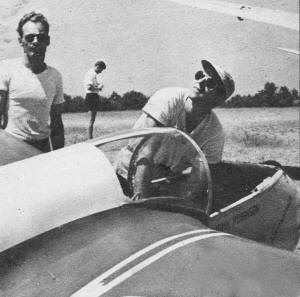
Judged the best team of the meet, John Robinson and crew
chief John Olley. A good crew chief is as important as a
good sailplane. Olley is considered the best.
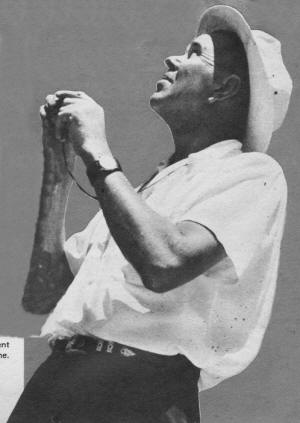
E. J. Reeves, Dallas, Texas, second time president of
Soaring Society, watches intently progress of a sailplane.
|
Evenings at Harris Hill were devoted mostly to the favorite sport
of all pilots - hangar flying. Suppers were served by various Elmira
civic and social organizations. By far the most important meeting
was that of the Institute of the Aeronautical Sciences attended
by such luminaries as T. P. Wright, former Administrator of the
Civil Aeronautics Administration, S. Paul Johnson, Director of the
Institute, and Roland Rohlfs of first Region CAA, in charge of Personal
Flying. Papers were presented by Dr. August Raspet, Director of
Research, Soaring Society of America, Dr. Alexander Lippisch, famous
German aerodynamicist, Robert Kidder of Cornell University Research
Laboratories and others.
On Saturday, the day before the closing of the meet, a special
speed event was held. Prizes were donated by Beech Aircraft Corporation
for the fastest flight from Harris Hill to Norwich, N. Y., First
place in this dash was won by Lyle Maxey flying a Minimoa sailplane;
Paul MacCready took second and Fritz Sebek of Homestead, Fla., flying
his special LK-10A, placed third.
The final day was devoted to ground activities on the hill. No
contest flights were scheduled in order that statisticians and judges
could add up scores and determine the winners of the different events
in preparation for the awards banquet held that night.
Principal speakers at the banquet, traditionally held at Elmira's
Mark Twain hotel, were Maj. Gen. Robert Webster, Commanding General
of the First Air Force; Maj. Gen. William D. Old, Commanding General,
Ninth Air Force; Admiral A. M. Pride, Chief, Naval Bureau of Aeronautics;
Capt. Ralph S. Barnaby, USN Retired; E. J. Reeves, who was elected
a second time as president of the Soaring Society of America (the
sanctioning organization for, the meet); as well as dignitaries
of the City of Elmira.
For amassing the. greatest number of points during the contest,
Paul MacCready, Jr., was crowned National Soaring Champion and awarded
the Richard C. duPont Memorial Trophy. MacCready collected in the
neighborhood of $1,500 of which $410 was point award money and the
rest cash prizes for different outstanding flights - for example,
$500, donated by Bendix for longest distance flight and $200 for
second fastest flight to Norwich.
Francis B. Compton was awarded the Warren E. Eaton Memorial Trophy
for his outstanding work in simplifying and arranging the contest
rules. The Lewin B. Barringer Memorial Trophy for the best distance
flight of the year made from automobile tow was won by Don Pollard
who in September 1947 flew from Elmira to Asbury Park, N.J. The
Douglas Aircraft Company Trophy for the championship soaring club
was presented to the Philadelphia, Pa., Glider Council.
The Northrop Aircraft Co. Youth Award of $100, awarded for the
top altitude performance by a pilot under 21, was captured by 17-year-old
Richard MCPherson of Elmira, N. Y.
One of the two prizes donated by Air Trails, each consisting
of a 350-ft. nylon air tow rope, was awarded to the best team. This
team consisted of Richard J. Corney, former National Soaring Champion
and Frank Hurtt, who between them shared Corney's Schweizer 1-21
sailplane. The other Air Trails award went to John Robinson for
making the most flights.
The Sperry Gyroscope prize, an Altitude Indicator, valued at
$577, went to Fritz Sebek for the best altitude reached during the
meet. A number of additional prizes were given out during the banquet.
Posted January 31, 2015
|





